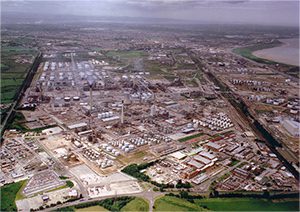- Petrol – 3 million
- Diesel – 3.5 million
- Jet A-1/kerosene – 2 million
- LPG/ petrochemical feedstocks – 1.5 million
- Fuel oil – 1 million
The refinery is assessed to supply approximately 15% of the country’s transport fuel requirements. Critically, it has a relatively high middle distillates (diesel and Jet A-1) yield of just over 50% – products where the UK has a growing structural deficit.
Movement of refined products
Pipeline accounts for 40% of the total movements. Products are supplied into the UKOP system for shipment to Kingsbury terminal and further south via a twin line built by Shell in the early 1980s. This enables movements via Buncefield, principally to Heathrow and Gatwick airports.
Road tanker movements from the refinery’s road loading facility account for 30%. This facility also services the local requirements of Esso, BP and Total.
Sea tanker vessels move 30% of product via the Manchester Ship Canal.
Playing a critical role in UK supply
The UK’s refinery network has reduced from 18 plants at the start of the 1980s to seven. With prospects for European refining profitability not providing any cause for optimism in the near term, there are growing concerns about the future viability of the UK network.
Stanlow, which is a significant source of supply of the UK’s total oil product requirements, also plays a critical role in supplying to the Mersey/Manchester area, the Midlands and Heathrow and Gatwick airports.
It is also an essential source of feedstock sourcing for the adjacent petrochemical complex.
The future of Stanlow
Essar Energy has signalled its ambition to expand its middle distillates capacity with the FCC unit recently undergoing a £23 million refurbishment. (See front cover of Fuel Oil News December 2013)
The refinery is believed to be currently running at approximately 75% of distillation capacity; a configuration that enhances its Nelson Complexity Index to an effective level of around 10.
In order to improve feedstock flexibility there are plans to discontinue lubricants production once existing customer requirements are satisfied. Whilst this activity only accounts for just under 2% of output, it ties down approximately 25% of the crude slate. Since February 2013, the proportion of North Sea crude oils run has dropped from 75% to under 50% with the balance now made up of Canadian, North African and West African material. It is also planned to phase out the use of fuel oil in the refinery’s six boilers and replace with gas firing.
The combination of these two initiatives is projected to improve the overall refining margin by $3 per barrel by 2014/2015.
The outlook for European refining may look gloomy but it would appear that in realising its profitability improvement plans, Stanlow will go a long way towards securing its future as a key strategic facility and source of supply in the UK market.
The History
Crude oil processing activities began at Stanlow in 1924 with the establishment of a bitumen manufacturing facility. During the 20th century this evolved into a full blown oil refining facility, owned and operated by Shell.
By the 1970s Stanlow was the flagship refinery in a network of five plants serving the country’s oil product requirements. By the start of the new millennium, subsequent rationalisation had resulted in the closure of all but one of Shell’s UK refineries – Stanlow.
As part of an ongoing review of its European refining network in 2010, Shell divested two facilities in Germany, selling Stanlow to Indian company, Essar Energy in August 2011.

